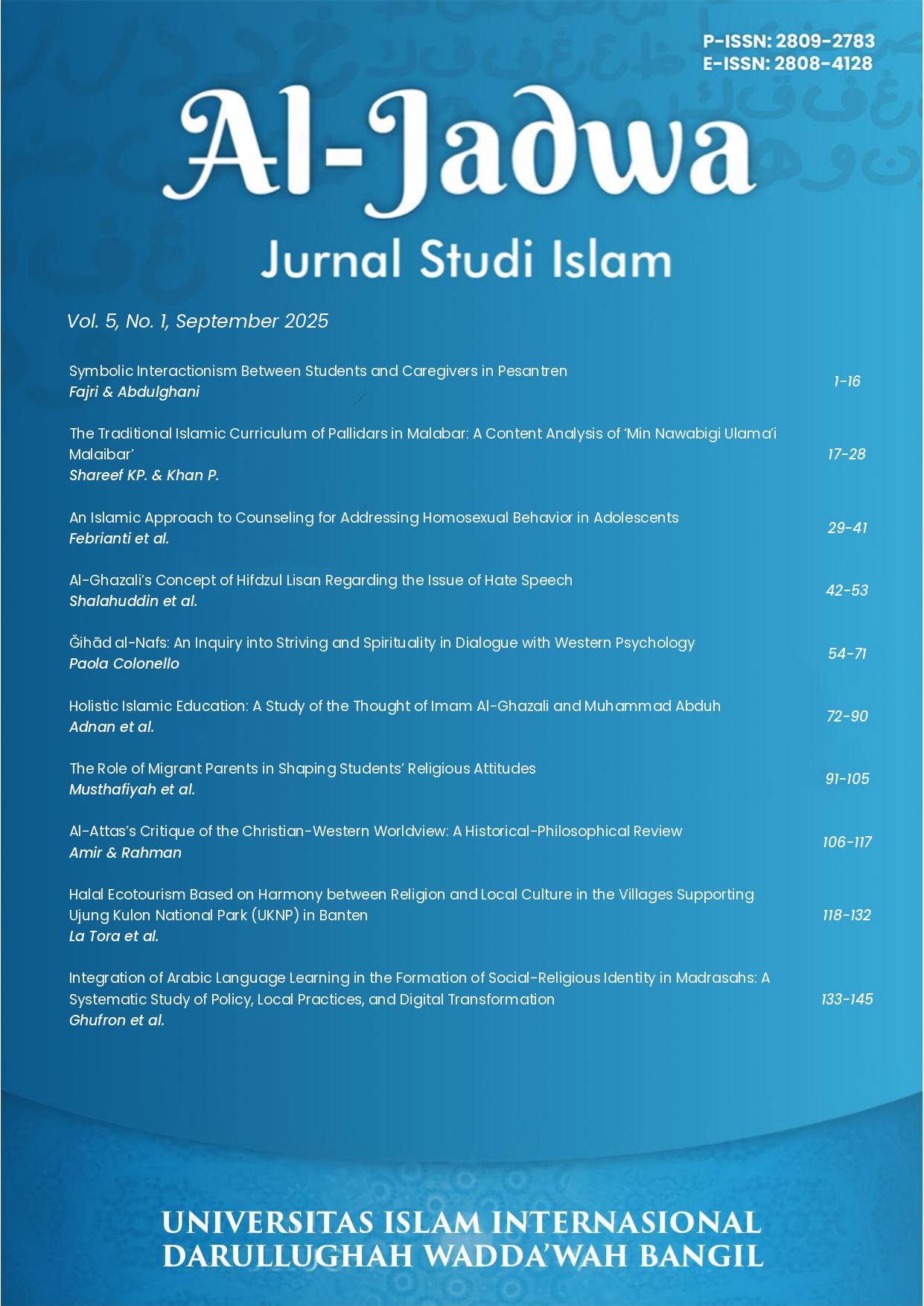Symbolic Interactionism Between Students and Caregivers in Pesantren
DOI:
https://doi.org/10.38073/aljadwa.3310Keywords:
Pesantren, Symbolic Interactionism, Abuya, Santri Values, Symbolic CommunicationAbstract
Amidst the current wave of modernization, challenges arise in preserving the traditional values that form the foundation of pesantren (Islamic boarding school) education. This study aims to examine how symbolic interactions between students and caregivers at the Pesantren Darullughah Wadda’wah (Dalwa) in Pasuruan contribute to the formation of the students' character and identity. Using a qualitative approach with descriptive-analytical methods, data were obtained through participant observation, in-depth interviews, and documentation. The results of the study indicate that symbolic interactions manifested through symbols such as the call "Abuya," gestures of respect, and daily rituals shape the social world of students based on five main values: sincerity, honesty, devotion, togetherness, and wisdom. These values are reproduced consistently through daily practices and become pillars of character education based on Islamic values. This study contributes to the development of the sociology of Islamic education through symbolic interactionism between students and caregivers in pesantrens, while also emphasizing the relevance of pesantrens as educational institutions that are adaptive but still rooted in tradition and the meaningfulness of education.
Downloads
References
Allergodt, Kristin, Bente Kristensen, Ulla Werlauff, Pia Dreyer, Marit Kirkevold, and Charlotte Handberg. “‘This Disease Is a Verdict You Must Live With for the Rest of Your Life’: Experiences and Perspectives From People Living With Adult-Onset Myotonic Dystrophy Type 1.” Qualitative Health Research, July 10, 2025, 10497323251356979. https://doi.org/10.1177/10497323251356979.
Arief, Mohammad, and Ridhatullah Assya’bani. “Eksistensi Manajemen Pesantren Di Era Digital.” Al Qalam: Jurnal Ilmiah Keagamaan Dan Kemasyarakatan 16, no. 6 (2023): 2548–67. https://doi.org/10.35931/aq.v16i6.1541.
Assa’idi, Sa’dullah. “The Growth of Pesantren in Indonesia as the Islamic Venue and Social Class Status of Santri.” Eurasian Journal of Educational Research, ANI Publishing Company, 2021. https://eric.ed.gov/?id=EJ1300132.
Biantoro, Oktio Frenki, and Asep Rahmatullah. “Internalisasi Nilai-Nilai Pendidikan Agama Islam Dalam Pembinaan Moral Siswa Di Sekolah.” Pelita: Jurnal Studi Islam Mahasiswa UII Dalwa 2, no. 2 (2025): 225–41. https://doi.org/10.38073/pelita.v2i2.3019.
Bijaksana, Asril. “Pendekatan Teori Interaksionisme Simbolik Dalam Metodologi Penelitian Kualitatif.” PESHUM: Jurnal Pendidikan, Sosial Dan Humaniora 4, no. 2 (2025): 2244–56.
Derung, Teresia Noiman. “Interaksionisme Simbolik Dalam Kehidupan Bermasyarakat.” SAPA: Jurnal Kateketik Dan Pastoral 2, no. 1 (2017): 118–31.
Efendi, Erwan, Farah Fadila, Khairi Tariq, Teguh Pratama, and Wardatul Azmi. “Interaksionisme Simbolik Dan Prakmatis.” Da’watuna: Journal of Communication and Islamic Broadcasting 4, no. 3 (2024): 1088–95.
Fauzan, Muhammad Faris, and Muhammad Zikry Zikrulloh. “Pengaruh Teori Strukturisasi Dalam Kehidupan Sosial.” Gunung Djati Conference Series 42 (2024): 332–39. https://conferences.uinsgd.ac.id/index.php/gdcs/article/view/2223.
Firmansyah, Irja Putra Pratama, and Munir. “Symbolic Meanings in the Social Interaction of Santri in the Pesantren Environment.” Al-Hayat: Journal of Islamic Education 8, no. 3 (2024): 1086–102. https://doi.org/10.35723/ajie.v8i3.698.
Fuad, Muskinul. “Therapeutic Aspects in Shalawatan Tradition (An Ethnographic Study on Shalawatan Communities in Banyumas).” Ijtimā Iyya Journal of Muslim Society Research 2, no. 2 (2017): 171–94. https://doi.org/10.24090/ijtimaiyya.v2i2.1636.
Gunawan, Wawan. “Kepemimpinan Kharismatik Kiai Dalam Implementasi Nilai-Nilai Pendidikan Pesantren Di Era Revolusi Industri 4.0.” Tadris: Jurnal Manajemen Pendidikan Islam 2, no. 1 (2023): 1.
Hamzah, Akhmad Fauzi, and Barlian Fajri. “Pesantren Ramah Perempuan Dan Anak Di Indonesia: (Studi Pada Pondok Pesantren Bahrul Ulum Tambakberas, Jombang, Jawa Timur Dan Boarding School Education Mu’allimat, Muhammadiyah, Yogyakarta).” Ta’wiluna: Jurnal Ilmu Al-Qur’an, Tafsir Dan Pemikiran Islam 5, no. 2 (2024): 399–418. https://doi.org/10.58401/takwiluna.v5i2.1828.
Haris, Aidil, and Asrinda Amalia. “Makna Dan Simbol Dalam Proses Interaksi Sosial (Sebuah Tinjauan Komunikasi).” Jurnal Dakwah Risalah 29, no. 1 (2018): 16–19.
Haris, Aidil, and Asrinda Amalia. “Makna Dan Simbol Dalam Proses Interaksi Sosial (Sebuah Tinjauan Komunikasi).” Jurnal Dakwah Risalah 29, no. 1 (2018): 16–19.
Haryanto, Sugeng. “Persepsi santri terhadap perilaku Kepemimpinan Kiai di Pondok Pesantren: Studi Interaksionisme Simbolik di Pondok Pesantren Sidogiri–Pasuruan.” Doctoral, Universitas Islam Negeri Maulana Malik Ibrahim, 2011. http://etheses.uin-malang.ac.id/10128/.
Himsyah, Unun Zumairoh Asr, and Asep Rahmatullah. “Konsep Pendidikan Hadhari Di Pondok Pesantren Darullughah Wadda’wah Bangil-Pasuruan.” Al-Jadwa: Jurnal Studi Islam 1, no. 1 (2021): 1–21. https://doi.org/10.38073/aljadwa.v1i1.460.
Huda, M. Syamsul. “Kultus Kiai: Sketsa Tradisi Pesantren.” Teosofi: Jurnal Tasawuf Dan Pemikiran Islam 1, no. 1 (2011): 113–30.
Izzaturrosyidah, Fatimah. “Perspektif Interaksi Simbolik Pengasuh Dan Santri Terhadap Kedisiplinan Mengikuti Pengajian Kitab Ta’lim Muta’allim Di Pondok Pesantren An-Nuriyah Ngronggo Kota Kediri.” Undergraduate, IAIN Kediri, 2020. https://etheses.iainkediri.ac.id/2719/.
Jannah, Alfia Miftakhul, Irada Haira Arni, and Robit Azam Jaisyurohman. “Kepemimpinan Dalam Pesantren.” J-CEKI: Jurnal Cendekia Ilmiah 1, no. 1 (2021): 42–49.
Karim, Abdul, Oman Fathurrohman, Muhammadun, Wahyu Saripudin, Diding Rahmat, and Firman Mansir. “Altruistic Works, Religion, and Corruption: Kiais’ Leadership to Shape Anti-Corruption Values in Pesantren.” Cogent Social Sciences 9, no. 1 (2023): 2238968. https://doi.org/10.1080/23311886.2023.2238968.
Ma’arif, Syamsul. “Education as a Foundation of Humanity: Learning from the Pedagogy of Pesantren in Indonesia.” Journal of Social Studies Education Research 9, no. 2 (2018): 104–23.
Mahani, Muhniansyah Arasyid, Wahyudin Wahyudin, Yahya Mof, and Suriagiri Suriagiri. “How the Values and Authentic Leadership Patterns of Kiai in Islamic Boarding School?” EDUKASIA Jurnal Pendidikan Dan Pembelajaran 6, no. 1 (2025): 1. https://doi.org/10.62775/edukasia.v6i1.1395.
Mukarromah, Lu’luil, Benny Prasetiya, and Mowafg Masuwd. “The Kyai Langgar as an Agent of Islamic Education: A Study on the Transformation of Roles in Ngepoh Village.” Halaqa: Islamic Education Journal 8, no. 2 (2024): 147–60. https://doi.org/10.21070/halaqa.v8i2.1696.
Pramitha, Devi. “Revitalisasi Kepemimpinan Kolektif-Kolegial Dalam Membangun Efektifitas Komunikasi Organisasi Pesantren (Studi Interaksionisme Simbolik Di Pondok Pesantren Jombang).” Journal EVALUASI 4, no. 1 (2020): 45. https://doi.org/10.32478/evaluasi.v4i1.355.
Putro, Ahmad Agung Yuwono, Suyanto, and Yoyon Suryono. “New Tradition of Pesantren in Character Education.” Journal of Physics: Conference Series 1254, no. 1 (2019): 012002. https://doi.org/10.1088/1742-6596/1254/1/012002.
Sarkowi, Sarkowi, Siti Aisyah, and Roshiful Aqli Qosim. “Symbolic Interaction of Kyai and Santri in The Perspective of Ethical Leadership Based on Religious Values.” International Journal of Multidisciplinary Research of Higher Education (IJMURHICA) 8, no. 3 (2025): 388–402. https://doi.org/10.24036/ijmurhica.v8i3.292.
Tubbs, Stewart L., and Sylvia Moss. Human Communication: Konteks-Konteks Komunikasi. Remaja Rosdakarya, 2005.
Van Bruinessen, Martin. “Pesantren and Kitab Kuning: Maintenance and Continuation of a Tradition of Religious Learning.” Texts from the Islands. Oral and Written Traditions of Indonesia and the Malay World [Ethnologica Bernica, 4]. Berne: University of Berne, 1994, 121–45.
Wanulu, Rukyah. “Makna Interaksi Simbolik Pada Proses Upacara Adat Cumpe Dan Sampua Suku Buton Di Samarinda.” Jurnal Ilmu Komunikasi 4, no. 3 (2016): 265–79.
Waskul, Dennis D., and Phillip Vannini. “Introduction: The Body in Symbolic Interaction.” In Body/Embodiment. Routledge, 2006.
Weismann, Ivan Th J. “Simbolisme Menurut Mircea Eliade.” Jurnal Jaffray 2, no. 1 (2005): 54–60.
Yani, Muhammad Turhan, Choirul Mahfud, S. A. P. Rangga Sa’adillah, Mohammad Reevany Bustami, Maskuri, and Ahmad Taufiq. “Advancing the Discourse of Muslim Politics in Indonesia: A Study on Political Orientation of Kiai as Religious Elites in Nahdlatul Ulama.” Heliyon 8, no. 12 (2022): e12218. https://doi.org/10.1016/j.heliyon.2022.e12218.
Zanki, Haritz Asmi. “Teori Psikologi Dan Sosial Pendidikan (Teori Interaksi Simbolik).” Scolae: Journal of Pedagogy 3, no. 2 (2020). https://doi.org/10.56488/scolae.v3i2.82.
Zhong, Lina, Xiangchi Qi, Sunny Sun, Jiating Liu, and Rob Law. “Symbolic Interactionism: Exploring the Experience of Traditional Costume in a Destination.” Current Issues in Tourism 28, no. 7 (2025): 1100–1115. https://doi.org/10.1080/13683500.2024.2323161.
Zuhdi, Muhammad. “Modernization of Indonesian Islamic Schools’ Curricula, 1945–2003.” International Journal of Inclusive Education 10, nos. 4–5 (2006): 415–27. https://doi.org/10.1080/13603110500430765.
Downloads
Published
How to Cite
Issue
Section
License
Copyright (c) 2025 Barlian Fajri, Naser Ali Abdulghani

This work is licensed under a Creative Commons Attribution-ShareAlike 4.0 International License.






